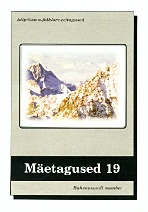Kurat, pattulangemine ja nõidus. Kristlike nõidade demonoloogia ja teoloogiline antropoloogia
Satan, Falling into Sin and Witchcraft. The Demonology of Christian Witches and Theological Antropology
Author(s): Dieter HarmeningSubject(s): History
Published by: Eesti Kirjandusmuuseum
Summary/Abstract: In Christian Europe, witches are usually spoken about in the context of inquisition and court. The concept of witches in Christian Europe is perhaps best described in Malleus Maleficarium. The topics listed there originate from the western theological tradition, not the fantasy of the book's author. The present article deals with statements concerning witches, dividing these into mythological, demonological and anthropological. Western demonology and concept of witchcraft is based on late Antique Neoplatonistic cosmology. According to this model, witching uses heavenly influences and powers, partly found in different cosmic elements and the nature of which corresponds the desired result. This scheme was adopted by early Christianity and modified to depict demons as fallen angels and their cosmic habitat to signify the place they had fallen to. They attempt to mislead people to become god-like. Witchcraft is thus treated as a set of symbols and signs to communicate with demons. Aquino Thomas introduces contracts with demons. By the 18th-century Enlightenment critics on superstition, significantly much of superstition is attributed to women, especially old women (e.g. the writings of Wilhelm of Paris, Johannes of Frankfurt and Nikolaus Jauer). Lactantius considers tendency towards superstition to be one of the weaknesses of the female nature. The terms connected with the old women's superstition include "old women's tales" (Ambrosius' aniles fabulae). Superstition is connected with worshipping idols. The 1487 Malleus Malleficarum represents the Augustinian teaching of sin, displayed in discussions of the credulity of women.
Journal: Mäetagused. Hüperajakiri
- Issue Year: 2002
- Issue No: 19
- Page Range: 135-154
- Page Count: 10
- Language: Estonian

